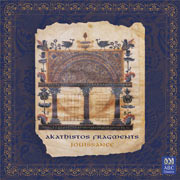Cat No 476 8064
http://shop.abc.net.au/browse/label.asp?labelid=3
 |
Although recorded at the acoustically neutral Iwaki studios, producers Jim Atkins and Tsiavos have created a gorgeous sonic space within which the cycle sits. The chimed bells of master percussionist Peter Neville and the at times almost ‘basso profundo’ of baritone Jerzy Kozlowski rest within a richly echoing context, at once wide and deep, yet sufficiently shaped and tweaked to go beyond a simple replication of the reverberance of a Medieval cathedral. The recording is simultaneously seductive yet complex, far from the faux historicism of most Gregorian chant recordings. At their thickest, Neville’s chimes and bowed gongs sound like they could resonate to infinity.
Neville, Kozlowski and cellist Tsiavos are joined by soprano Deborah Kayser and shakuhachi player Anne Norman. The CD begins with passages of often highly syncopated singing from Kayser, answered by active contemporary instrumental responses. Norman makes the most of the special character of the shakuhachi: sharp, highly pitched accents and extended, stretched notes hover over the other instruments or make up short lead sections. Periods of sustained, strongly tongued vibrato feature within the most intense exchanges, such as the tightly controlled storm of instruments on track five (a Thracian dance).
Each instrument has a track in which it leads. Tsiavos presents a gorgeous cello solo, at once mildly Romantic in tone, yet with a rough, grating texture to the bowing, lying deep and hard within a hummed vocal wash (track eight), while on track 10 Neville fills the space with lightly buoyant timbres. As the tracks progress, the vocals eschew the tightly clipped enunciation of Kayser’s initial delivery to rise and glide over passages in a fashion more familiar in Early Music. A kind of questioning emerges with the shakuhachi, then the cello, speaking out after these motifs creating an enticing sense of non-resolution. The cycle ends with a minimalist rhythmic percussion and cello section underpinning soaring vocals.
There is an implicit narrative at the heart of the Byzantine motifs reworked here, which although related in the liner notes, remains largely opaque to modern listeners. This matters little however as the sheer gorgeousness of these works, tinged with a sense of divine tragedy, more than carries the cycle. In the context of so much spiky, acerbic New Music, it is a rare pleasure to find such a luscious new work.
Jonathan Marshall
© Jonathan Marshall; for permission to reproduce apply to [email protected]








 back
back